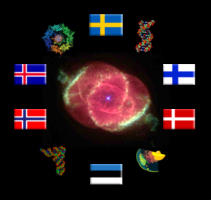Water, Ice and the Origin of Life in the Universe
CGB will be taking an active role in an Astrobiology summer school addressing these issues 29 June-13 July 2009. Professor Nils-Kåre Birkeland will be one of the lecturers, lecturing on the "Genetics of thermophiles" and the "Molecular basis of the stability of biomoleculees in hot environments". Researcher Ida Helene Steen and research assistant Solveig Hoem are leading some of the lab courses and PhD students Irene Roalkvam and Ingeborg Økland are participants.

Hovedinnhold
Summer school organisers selected this topic because water is fundamental to life as it is known on Earth, and thus may be critical for life on other planets.
Among the central issues that will be addressed include:
- How was / is water formed in space?
- What role does it play in planet formation?
- How did water reach Earth's surface?
- How did life finally emerge in water under the extreme conditions prevailing on early Earth?
From the school web site we learn that the programme aims to give participants a thorough high-level introduction into the role of water in the evolution of life in the cosmos, starting from formation of water molecules in space and ending with evolution of the first organisms. Lab work on extremophiles (especially organisms living in very hot or cold water) will complement the teaching, since much can be learned about the evolution of life under the very harsh conditions prevailing on early Earth by studying such species.
Astrobiology is a multidisciplinary field and the Summer School will bring together students and researchers from a multitude of different science branches. It was organised by the Nordic Network of Astrobiology Graduate Schools together with the NASA Astrobiology Institute.
The school is located in Iceland as it is an ideal venue for such an event, providing ideal habitats for cold- and hot water extremophiles (subglacial lakes and hot springs).
Steen and Hoem have prepared lab activities that include a number of valuable microbiology techniques including: microscopy, quantification of cultivable aerobic bacteria, DNA isolation from enrichment cultures, PCR, DGGE: Casting, Loading, Running, CFU and DGGE: Staining visualisation, documentation.
